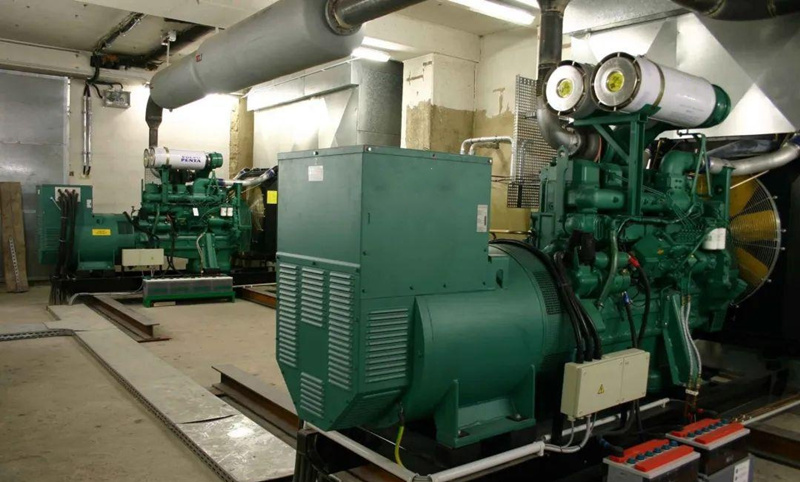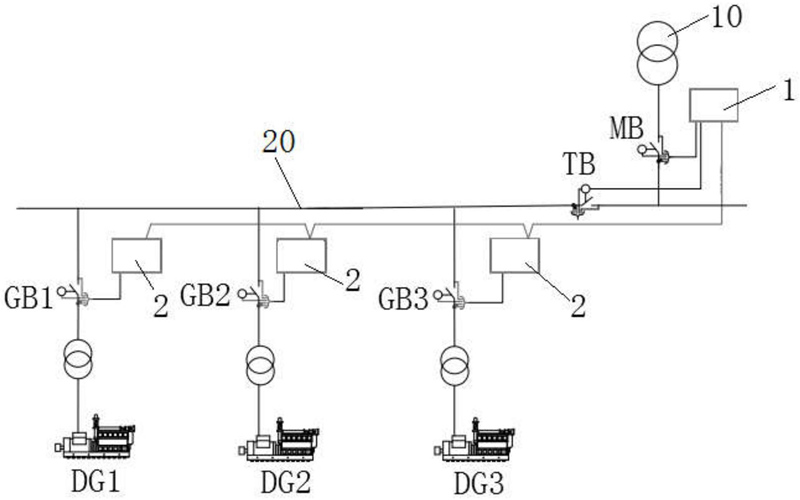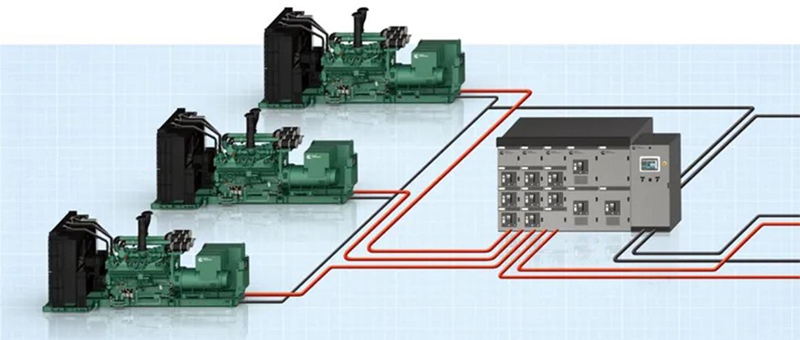Conditions for parallel operation and grid connection of diesel generator
Writer:SHILIDER
Pubdate: 2023-03-21 15:03:05Update: 2023-04-07 11:04:37

SHILIDER
Shilider Technical Engineer
GET QUOTE
1. What are the conditions for parallel operation of generator sets?
The entire process of putting the generator set into parallel operation is called parallel operation. Run one generator set first, transmit voltage to the bus, and after the other generator set starts, it should be parallel to the previous generator set. At the moment of closing, the generator set should not have harmful impact current, and the shaft should not be suddenly impacted. After closing, the rotor should be able to be quickly pulled into synchronization. Therefore, the parallel connection of generator sets must meet the following conditions:
a. The effective value and waveform of the generator set voltage must be the same
b. The voltage phases of the two generators are the same
c. Both generator sets have the same frequency
d. The phase sequence of the two generator sets is consistent
2.What is the quasi synchronous parallel method of generator sets?How to coordinate the same period?
Quasi synchronization is the exact period. For parallel operation with quasi synchronization method, the generator sets must have the same voltage, same frequency and same phase, which can be monitored by two voltmeter, two frequency meters, synchronization meter and non synchronization indicator installed on the synchronization panel. The parallel operation steps are as follows:
Turn on the load switch of one of the generator units and send voltage to the busbar, while the other unit is in a standby state. Close the synchronous switch, adjust the speed of the standby generator set to be equal to or close to the synchronous speed (with a frequency difference of less than half a cycle from another unit), adjust the voltage of the standby generator set to be close to the voltage of the other generator set. When the frequency and voltage are similar, the rotation speed of the synchronous meter becomes slower and slower, and the synchronous indicator light is also on and off; When the phase of the standby unit is the same as that of another unit, the pointer of the synchronization meter indicates the up center position, and the synchronization light is the darkest. When the phase difference between the standby unit and the other unit is the largest, the pointer of the synchronization meter points to the down center position, and the synchronization light is the brightest. When the pointer of the synchronization meter rotates in a clockwise direction, it indicates that the frequency of the standby generator is higher than that of the other unit, and the speed of the standby generator set should be reduced, On the contrary, when the pointer of the synchronous meter rotates counterclockwise, the speed of the standby generator set should be increased. When the pointer of the synchronous meter slowly rotates clockwise and approaches the synchronous point, immediately close the circuit breaker of the unit to be paralleled, so that the two generator units are parallel. After parallel operation, cut off the synchronous meter switch and related synchronous switches.
3.What should be paid attention to when performing quasi synchronous paralleling of generator sets?
Quasi synchronous parallel operation is a manual operation, and the smooth operation is closely related to the experience of the operating personnel. To prevent asynchronous parallel operation, the following three situations are not allowed to be closed. When the pointer of the synchronous meter jumps, it is not allowed to close because there may be jamming inside the synchronous meter, which cannot reflect the correct parallel conditions. When the synchronization meter rotates too fast, it indicates that the frequency difference between the standby generator set and another generator set is too large. Due to the difficulty in controlling the closing time of the circuit breaker, it often causes the circuit breaker to not close at the synchronization point, so it is not allowed to close at this time. 3. If the pointer of the synchronous meter stops at the synchronous point, it is not allowed to close when it stops. This is because if the frequency of one of the generator sets suddenly changes during the closing process of the circuit breaker, it is possible to cause the circuit breaker to close at a non synchronous point.

4.How to adjust the reverse power phenomenon of parallel units?
When two generator units are parallel without load, there will be a problem of frequency difference and voltage difference between the two units. And on the monitoring instruments of the two units (ammeter, power meter, power factor meter), the actual reverse work situation is reflected. One is the reverse work caused by inconsistent speed (frequency), and the other is the reverse work caused by unequal voltage. The adjustment is as follows:
a. Adjustment of reverse power caused by frequency: If the frequencies of two units are not equal or have a significant difference, on the instrument (ammeter, power)
The table shows that the current of the unit with high speed shows a positive value, while the power meter indicates positive power. Conversely, the current indicates a negative value, and the power indicates a negative value. At this point, adjust the speed (frequency) of one of the units and adjust it according to the indication on the power meter. Adjust the indication on the power meter to zero. Make the power indication of both units zero, so that the speed (frequency) of both units is basically the same. However, when the ammeter still shows an indication, this is the reverse work phenomenon caused by the voltage difference.
b. Adjustment of reverse power caused by voltage difference: When the power meter indications of both units are zero, but the ammeter still has current indication (i.e. one reverse and one positive indication), the voltage adjustment knob of one of the generator units can be adjusted. The adjustment should be based on the indication of the ammeter and power factor. Eliminate the indication of the ammeter (i.e. adjust to zero), and after the ammeter has no indication, adjust the power factor to a hysteresis of 0.5 or more based on the indication of the power factor meter. Generally, it can be adjusted to around 0.8, which is the optimal state.
5.Generator protection circuit
a. The phenomenon of reverse power and reverse power is caused by differences in the speed (frequency) and voltage of a generator set, where one generator set carries positive power while the other unit carries negative power. That is to say, the unit with negative power becomes a load (the phenomenon of low frequency and inconsistent speed of this unit). When the voltage is different, the unit with high voltage provides a reactive current and reactive voltage (positive indication of the ammeter of the unit) to the unit with low voltage, which is equivalent to adding a condenser unit in the power supply system. The unit with low voltage becomes a large load and receives a large reactive current to maintain the voltage balance of the two units (the ammeter of this unit indicates the reverse direction). When monitoring, the voltage of one unit is raised, or the voltage of another unit is raised or lowered, causing one unit to have reverse current, and its operating current is about 20% of the rated current. Reverse action relay operates, trips, alarms, but does not stop.
b. Overcurrent: The rated power of the current generator set is certain, and its overload capacity is very low, basically around 5% of the rated power. The allowable load time is 15-30 minutes, with a maximum of 60 minutes. After this time, the generator set will heat up, and the insulation of the wires will decrease, thereby reducing its service life. So if there are no special requirements when setting overcurrent protection, it can be set at 110% of the rated current. During the load test, bring the current to 110% of the rated current and the overcurrent relay acts. Trip, alarm, no shutdown.
c. Overvoltage: When using generator sets in parallel, the most fear is that the power supply system will oscillate. Once the oscillation occurs, the system voltage will rise, which can easily cause insulation breakdown of the electrical equipment and power supply equipment, causing both the power supply equipment and the electrical equipment to be paralyzed. The generator sets used in parallel for this purpose are equipped with overvoltage protection, and the optimal setting is 105% of the rated voltage. Short circuit overvoltage relay, trip shutdown, alarm action
6.The opening and closing circuits are connected to the mobile phone in parallel and automatically parallel control circuits.
a. Manual opening and closing: Each unit can be used as the first unit or as a standby for opening and closing. During manual parallel operation or power supply, manual opening and closing are used.
b. Automatic opening and closing: Each unit can be selected as a standby unit or the first unit; After the first unit starts, the closing circuit automatically closes, automatically switches on and off the synchronization. After the synchronization, the standby units will automatically close and operate in parallel.
c. Whether it is manual closing or automatic closing, once the unit experiences reverse power and passes through low oil pressure, high water temperature, high water temperature, high oil temperature, or overvoltage, all automatic opening and disconnection will occur and the load will be disconnected.
7.Synchronous circuit
a. When the first machine is switched on, the power is sent to the busbar. At this time, the busbar detects the synchronous circuit, which is connected to the synchronous circuit of the machine to be connected. Upon receiving the signal, the synchronous detection relay is automatically closed. Send the bus voltage and the voltage of the standby unit to the synchronous control module, which automatically detects and parallels the voltage and speed of the unit. If there is a difference in speed, the synchronization module automatically adjusts the speed of the standby machine to achieve parallel conditions. After finding the synchronization point, the synchronization module sends a closing command, and after the parallel units receive the command, they execute the closing, that is, the two units operate in parallel.
b. After the units are paralleled, the synchronization circuit will automatically exit the working state, but the automatic synchronization transfer switch must be manually removed to prevent the parallel device from being automatically put into operation again when the parallel unit receives a parallel signal during disconnection after an incoming call, so that the units can be paralleled again.
8.Load distribution
a. When running on a single machine, the load distributor is not put into operation.
b. After the units are paralleled, the load distributor of each unit is put into operation, and each unit adjusts its own speed to evenly distribute the power of the two units. The working principle is to automatically adjust the speed of each unit based on the output power of the unit (i.e. the current), so that its load is even
9.Voltage adjustment circuit
a. Before paralleling the units, the voltage of both units must be adjusted to the same value.
b. After no-load paralleling, adjust the voltage knob to eliminate the reverse power phenomenon and make its power factor lag around 0.8.
c. After the parallel units are loaded, the voltage adjustment knob can be manually adjusted according to the load situation to ensure that the power factor is at the optimal position, and there is no need to adjust it in the future.
10.Speed adjustment circuit
a. Before paralleling, the speed (frequency) of the two units must be adjusted to be consistent.
b. When parallel, the speed of the first or standby unit can be adjusted according to the rotation speed of the synchronous meter, so that the direction of rotation of the synchronous meter can be clockwise or counterclockwise. The slower the speed, the better. However, the pointer of the synchronous meter must be rotated in order to be parallel.
c. After parallel operation, observe whether the current and power of the two units are balanced. If the difference is too large, adjust the speed knob to adjust the power of the two units
11.Instrument detection circuit
a. Before operation, various related instruments must be adjusted to zero, but the power factor meter and frequency meter are not at zero.
b. During operation, observe the operating status of various instruments to see if they comply with regulations (whether there is any phenomenon of instrument wiring being reversed).
c. Current and voltage should be checked with relevant instruments to see if the indicated values are normal.
12.Start circuit
a. Before operation, it is necessary to first check whether the starting circuit is normal.
b. Whether the relevant components can work normally after startup.
c. Is the connection between the starter and the host working properly and is it possible to exit.
13.Shutdown circuit
a. Check if the action of the shutdown electromagnet and solenoid valve is reliable.
b. Whether to automatically shut down the unit when it malfunctions.
c. Is the manual shutdown circuit complete.
d. Whether to stop the machine or not when it only needs to be tripped.





 Prev:How to Design Diesel Generator Room
Prev:How to Design Diesel Generator Room Next:14 of the world's best generator set suppliers and manufacturers
Next:14 of the world's best generator set suppliers and manufacturers![]()